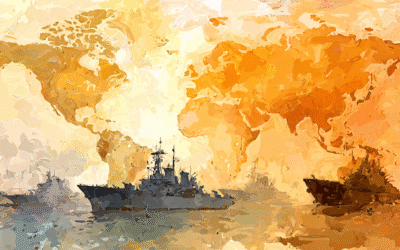TL;DR – Measure peace, not pauses
Ceasefires can stop the gunfire, but they don’t heal what caused it. The Peace Integrity Score is a new framework for judging whether a so-called “peace deal” is genuine or just a temporary truce. It measures six essentials—durability, inclusion, justice, human rights, equitable development, and prevention architecture—so policymakers, journalists, and citizens can tell the difference between quiet and true peace.
When leaders hail a “historic peace deal,” the media often frames it as a moment of triumph – a certificate of resolution. But ceasefire agreements without justice, participation, or durable institutions often collapse. To sharpen our lens, we propose the Peace Integrity Score: a framework to assess whether a peace process truly transforms conflict dynamics – or merely freezes them.
This is not just theoretical. In Gaza, Yemen, Lebanon, and the Saudi–Israel normalization talk, we see the pattern: deals that stop bullets – but leave structures of violence and exclusion untouched. Below, we explore how recent peace or truce efforts fare when measured by six essential dimensions of integrity.
What the Peace Integrity Score Measures
The Score offers six interconnected dimensions, each serving as a checkpoint. A deal might perform well on one but fall short on others; the overall integrity comes from balance and coherence.
| Dimension | Key Question | Why It Matters |
| Durability of Nonviolence | Did the conflict pause and stay paused? | True peace must hold without constant military enforcement or the threat of relapse. |
| Inclusion | Were affected populations (displaced people, civil society, women, minorities) part of the design? | Without participation, agreements often alienate victim groups and fuel resentment. |
| Justice and Accountability | Are systems for truth, restitution, prosecution, or reconciliation present? | Unaddressed abuses leave grievances unhealed and often sow seeds for future conflict. |
| Human Rights Protection | Does the new context safeguard freedom, expression, due process? | Peace built on silenced voices or authoritarian control can mask injustice. |
| Equitable Development | Do peace dividends reach everywhere, not just elites? | Benefits concentrated in power centers reproduce inequality tensions. |
| Conflict – Prevention Architecture | Is there a mechanism (monitoring, mediation, dispute resolution) to prevent relapse? | Peace needs guardrails, not just signatures. |
Let’s apply this to current Middle Eastern contexts.
Gaza–Israel (2025): Pause or Peace?
What is happening now
As of October 2025, Israel and Hamas are convening indirect negotiations in Egypt for a potential ceasefire combined with a hostage – prisoner exchange. U.S. envoy Steve Witkoff is participating. President Trump has publicly declared that Israel has consented to an “initial withdrawal line,” promising an immediate ceasefire upon Hamas’ acceptance.
Yet, despite these diplomatic overtures, Israeli airstrikes continue in Gaza, and civilian casualties mount.
Earlier in 2025, a ceasefire agreement had been in place (January – March) but ended abruptly when Israel launched renewed airstrikes.
Scoring Gaza (tentative)
- Durability
- The 2025 ceasefire collapsed after Israel resumed strikes in March, undermining trust.
- The current negotiations are fragile – despite optimistic talk, the risk of relapse is high.
- Inclusion
- The talks are being conducted by state and armed actors, with little public evidence that displaced civilians, women’s organizations, or independent Palestinian voices have a seat at the table.
- The dominant parameters on the table (governance transfer, disarmament, prisoner exchange) are elite-driven.
- Justice and Accountability
- No robust mechanism has been proposed for investigating wartime abuses, forced displacement, or proportional compensation.
- Questions about accountability for war crimes remain sidelined.
- Human Rights Protection
- Even in ceasefire phases, restrictions on movement, access to aid, press freedom, detentions, and governance constraints persist.
- Power in Gaza remains contested.
- Equitable Development
- Reconstruction is proposed as one of the “dividends,” but the allocation model is unclear. Will it benefit all neighborhoods? Rural areas? Will it avoid reinforcing patronage networks?
- Conflict-Prevention Architecture
- There is discussion of phased withdrawal and third-party guarantees.
- But no strong, independent monitoring or dispute resolution structure is yet evident in the public negotiations.
Overall assessment (Gaza): The proposed ceasefire and exchange deal offers promise of respite – but so far it ranks as a pause with low integrity, not a structural peace. The absence of accountability and inclusion, combined with prior collapse, suggests high fragility.
Yemen / U.S.–Houthi Truce (2025)
What is happening now
On 6 May 2025, the U.S. and Houthi rebels reached a ceasefire agreement mediated by Oman to halt attacks on vessels in the Red Sea.
However, the truce did not extend to internal Yemeni frontlines or the broader civil war context.
Even before this, Yemen had been under a fragile stalemate since a UN-backed truce in 2022, which held in varying degrees.
Critics warn the new deal is tactical – relating to maritime security – not a true peace deal, and may be vulnerable to breakdown.
Scoring Yemen (tentative)
- Durability
- The 2022 truce held partially, though violations are frequent.
- The 2025 truce is narrowly scoped and contingent; there is no guarantee it will survive shifts in regional dynamics.
- Inclusion
- The agreement was between the U.S. and Houthis; local Yemeni factions, civil society, southern resistance groups, or women’s representatives had little role in framing it.
- Justice and Accountability
- No advancement in mechanisms for war crimes, rights abuses, or dealing with famine/ blockade consequences.
- Human Rights Protection
- The ceasefire halts strikes on vessels, but internal pressures and violations persist. The rights environment inside Yemen is largely untouched.
- Equitable Development
- Maritime stability yields trade gains, but internal reconstruction, resource access, and basic services remain poorly addressed.
- Conflict-Prevention Architecture
- The deal lacks strong institutional dispute mechanisms. It is tactical and reactive, not visionary or systemic.
Overall assessment (Yemen): The truce is a tactical instrument tied to shipping and external pressures. In terms of integrity, it scores low except on reducing maritime violence; it does little to restructure the civil war.
Lebanon / Israel Front & Proxy Escalations
Lebanon often moves under the radar, but periodic skirmishes between Israel and Hezbollah continue to impose a low-grade conflict status. During ceasefire windows or unspoken understandings, casualties decline but no structural resolution emerges.
This pattern exemplifies the “frozen frontier” phenomenon: a boundary where violence is limited but political claims, arms accumulation, and existential tensions endure. Such frontlines rate very poorly on most Peace Integrity metrics: little inclusion, no accountability, weak prevention architecture.
Saudi–Israel Normalization Narratives
While not a conventional war cessation, the push for normalization between Saudi Arabia and Israel is frequently enveloped in peace rhetoric. But the deal’s credibility hinges on whether it addresses the Palestinian question, justice, and inclusion – not just strategic interests.
On the Peace Integrity scale:
- Inclusion & justice are often marginalized or ignored.
- Conflict-prevention systems are not built in; security deals and arms flows dominate.
- Without a rights or restitution track for Palestinians, normalization may embed inequality under the guise of peace rather than heal past wounds.
Why the Score Matters (and What Australia Can Do)
Accountability in the Spectacle Age
Modern peacemaking increasingly leans on spectacle: a handshake, a photo op, a deal announcement. But if internal structures remain unchanged, the peace is superficial. The Score helps us move beyond aesthetic metrics – to outcomes. It asks: was this transformative, or just transactional?
Australia’s Role
Australia is not a frontline actor in these conflicts. That gives us moral leverage to champion integrity standards:
- Embed the Score in aid obligations. Canberra can condition humanitarian and reconstruction funding on compliance with inclusion, accountability, and monitoring provisions.
- Support independent verification. Back regional or Australian civil society coalitions in producing “Peace Integrity audits” for deals in the Middle East or Asia.
- Promote education and journalism. Encourage media and universities to adopt the Score lens: don’t let ceasefires command headlines without assessment.
- Offer a peace metrics model. Australia could propose a Pacific-Asia adaptation of the Score framework – connecting our region’s conflicts and peacebuilding to global standards.
Beyond the Silence of Truces
Ceasefires provide breathing space. But peace demands more: repair, dignity, inclusion, accountability, and systems that guard against relapse. The Peace Integrity Score does not declare winners or moral absolutes. It offers a compass.
In Gaza, we see the promise of pause – but the fragility of structure. In Yemen, a truce built for shipping intercepts only scratches the surface of internal rupture. On other fronts, truth is silenced and agency overlooked.
We cannot let applause for silence drown out the voice of justice. Peace is not the absence of explosions – it is the presence of right relations. The Peace Integrity Score calls us to refuse the illusion of peace and measure what truly matters.










0 Comments